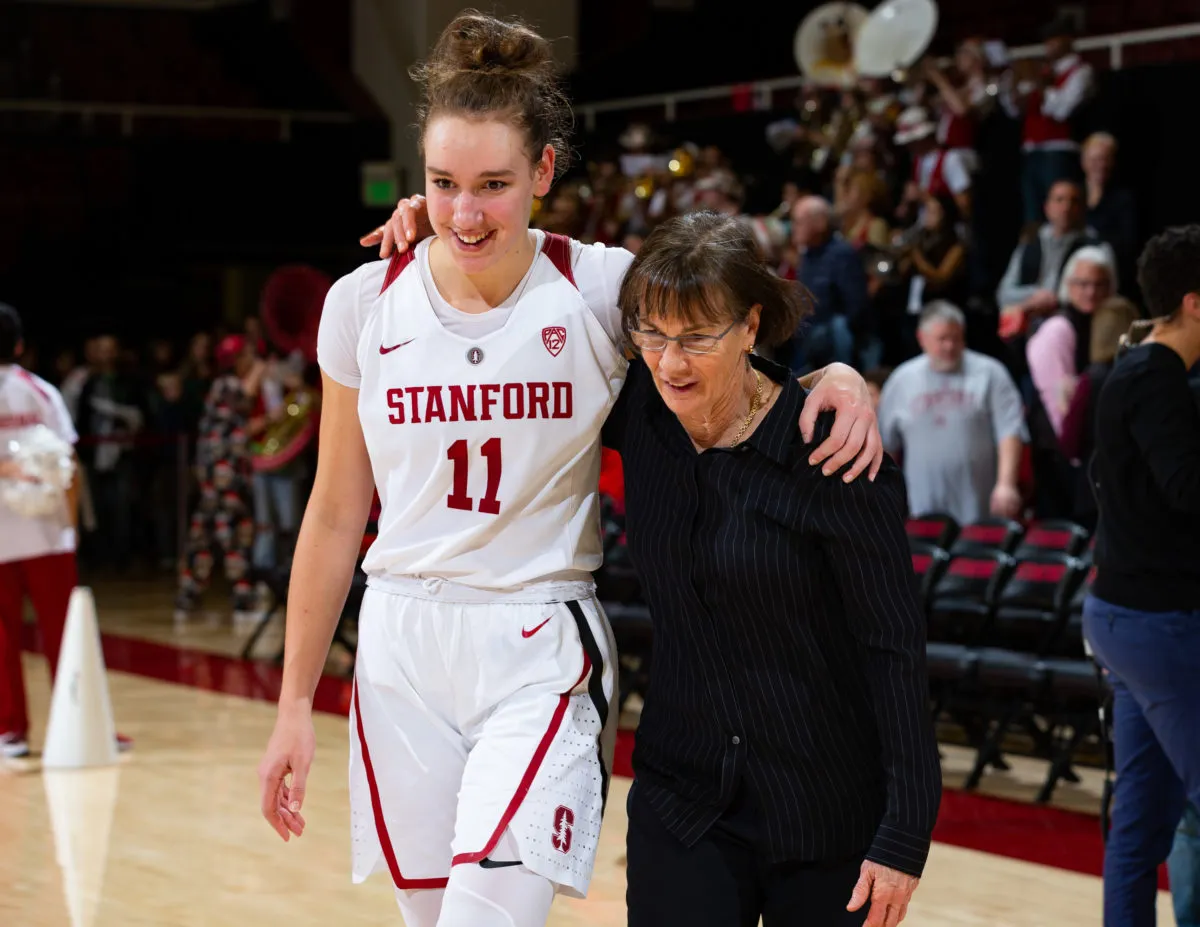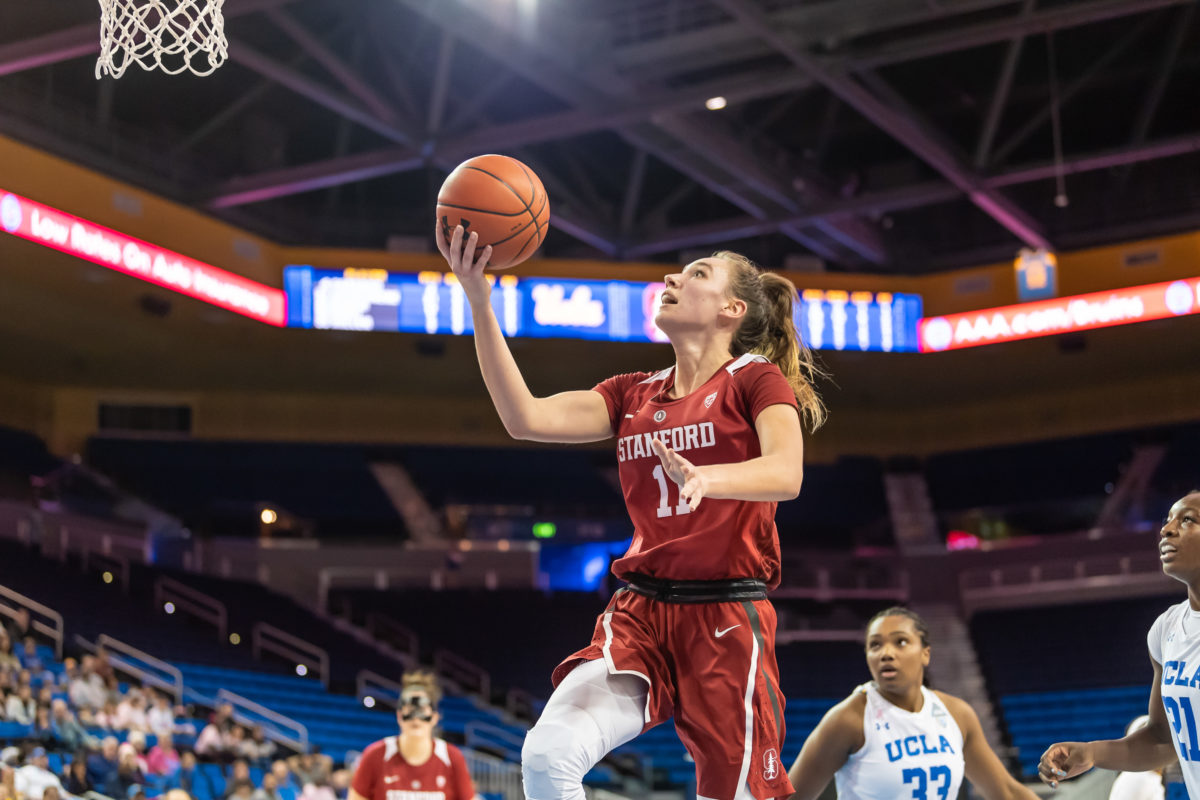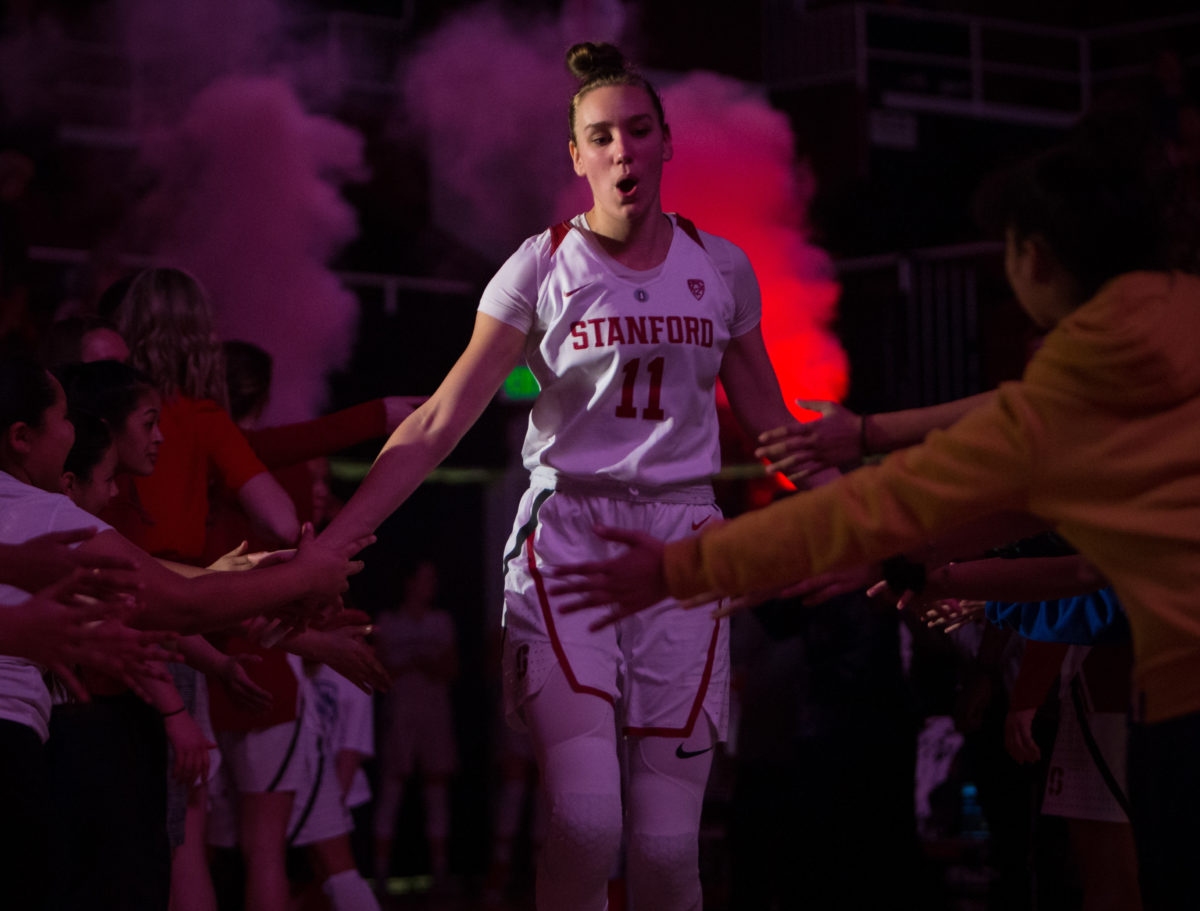This article is part of a running series The Daily sports staff will be publishing on graduating seniors.
Stanford’s first international women’s basketball recruit, Alanna Smith has enjoyed the successes of a standout senior season for which she was named an All-American. Smith was also the 12th Cardinal to be named All-American and to be drafted in the first round of the WBNA draft. The Phoenix Mercury selected her with the eighth pick of the 2019 draft. Smith was awarded the 2019 Pac-12 Scholar-Athlete of the Year Award for women’s basketball. She joins the ranks of Elena Delle Donne, Maya Moore and Breanna Stewart as the NCAA’s only women to have 1,600 points, 150 threes and 200 blocks in the last 20 years. Outside of Stanford, Smith was a member of the Australian National Team for the 2018 FIBA World Cup. The Daily’s James Hemker sat down with Smith to reflect on her time, both on and off the court, at Stanford.
The Stanford Daily (TSD): Do you remember your first Stanford practice?
Alanna Smith (AS): I do remember my first practice. I had been here for two weeks already. I was really nervous, as I hadn’t met anyone that much yet. It was really hard, and I was really tired. However, I got along well with my other teammates, and I was excited to get started.
TSD: You said in an interview early in your career here that you had always planned on coming to California for school. Was the move easier or harder than you anticipated?
AS: [laughing] It was a lot harder than I thought it would be. It took me a long time to adjust to the time difference and to being in school. I had been out of school for a while because we graduate high school a lot earlier than you guys do. The college basketball schedule is tough to get used to, so it took me a long time. I struggled through it but I had really good teammates and other people to help me through it.
TSD: Looking back, does it feel like a blur?
AS: In a way, yes. My senior year has been crazy fast, but I remember my first couple of years I was like, “Oh my gosh, this is crazy slow.” But now it’s flown by. Like the saying, “When you are having fun and having a good time, it goes by really fast.”
TSD: What are some of your favorite moments that have happened over the years?
AS: For on-court stuff, we went to the Final Four during my sophomore year. We beat Notre Dame on a last-second shot. Outside of that, the moments I remember are the moments I’ve been around my friends and my teammates and spending quality time with them.

TSD: You’ve been very vocal recently about your struggles with anxiety and the importance of mental health. Why was it important for you to speak out about it?
AS: I think it’s important because as an athlete, people tend to forget about the mental side of the game. They watch all of your physical conquests in games, and all the accolades for winning, but people don’t really know what goes on behind the scenes, what an athlete is thinking. It’s stressful. There is a lot of pressure, especially as a student-athlete, because you have school on top of games and everything. Bringing mental health into the public eye and making it easier for athletes to voice their stories and concerns is really important because it’s a huge part of the game. For everybody, not just athletes, mental health in general is important, and we need to talk about it.
TSD: After the piece on gostanford.com, have you had people come up to you and talk to you about your stepping forward?
AS: Yeah, I’ve had some parents come up to me and say, “Thanks, it was really cool to read the piece. My daughter watches you and she has struggled with anxiety before.” What’s really cool as well is that athletes on campus are coming out and speaking out more about these issues. There was an event called GameFACES, where different athletes were talking about their stories, and some of them focused on mental health. So it’s not just me, there are other people doing it as well. There is a program with athletics called Cardinal RHED that is focused on mental health. It’s really cool to see that aspect of the game brought into the light.
TSD: A lot of people have been calling your senior year your breakout year on the court. Did it feel like something clicked and it really was a breakout year, or did it feel more like a culmination of everything you had been doing?
AS: I think it’s probably a combination of things. Every year I have improved, and that’s the goal for every athlete: to be better than they were last season. That’s what my goal had been every year for Stanford, and with this being my last year, I definitely had a sense of urgency to leave it out on the court. I also had a lot of help. I was playing with the national team last summer, so that gave me a little bit of confidence. It’s definitely culminated over the full four years of Stanford and that mentality of improving after every season.
TSD: Would you say your playing with the national team was one of the bigger pieces of your success?
AS: Yeah, definitely. I think that experience of playing with some of the best players in the world and then playing against some of them is invaluable. You can’t get that anywhere else. You’re also getting that confidence from your teammates, coaching staff and the actual playing experience. I couldn’t ask for anything better for preparation. It really was pretty integral in how I played out my senior year.
TSD: After going through international games, did the college level feel easier or not as tough?
AS: No, I don’t think so. Obviously when you’re playing against Team U.S.A. or Spain or China, there are just different styles to the game. I think the college system is tough, especially in our conference. Our conference is probably the toughest in the country to play in. I can’t say that when I was playing in the conference I was going, “Oh, this is so easy,” because it wasn’t. It was really hard. Some of the games we played were absolute battles. Obviously international basketball is a step above, so it was a really cool opportunity to play internationally and then come back and play here too.

TSD: Are you a superstitious player? Do you have any general game day routines you like to go through?
AS: I wouldn’t say that I’m superstitious, no. I don’t always put on my right shoe then my left shoe. I don’t do that. Before every game I do always sit and try and get into a quiet space and do some visualization stuff. That helps on the mental side of things to get into the zone. Also knowing that you can do the things that you have done in the past definitely helps. So a lot of visualization stuff, a lot of mental preparing.
TSD: What are some things from Australia that you would want to bring to America, and what are some things Australia could learn from America?
AS: I’m from Melbourne, and Melbourne has a really big cafe scene. It’s similar to Europe, and everyone goes out to brunch and gets coffee. There’s a big brunch culture. If you’re going to see someone, you go out to a cafe, and the food and coffee is always really, really good. I wish I could bring that from Melbourne to here because I miss that a lot.
There are so many things I would like to bring back home. I love how before football games everyone tailgates. I didn’t even know what it was before I got here. I remember other people were like, “Yeah, we’re gonna go tailgate,” and I was just like, “Uh, tailgate?” But now I know, and they’re super fun.
TSD: Hopefully you experienced a tailgate somewhere other than Stanford, as we are admittedly on the low end of the tailgating spectrum.
AS: I have some family in Ohio, so I did some tailgating at Ohio State, and they know how to really do it. It was pretty awesome.
TSD: What was draft day like?
AS: It was a crazy whirlwind. We lost in Chicago on a Monday, and we were on the flight back to San Francisco the Tuesday after. On the flight they told me I was going to Tampa the next day. So from San Fran to Tampa to watch the Final Four. I received the All-American award there, and then I went from Tampa to New York. It was such a whirlwind, but it was so fun.
That week was one of the craziest but coolest weeks ever. I loved New York. It was a crazy cool city. We did a full day of orientation with the WNBA about learning the transition from college athletics to the professional league.
And then the draft day itself was so fun. I got dressed up and had my hair and makeup done. There’s photos and you’re on TV. When you’re drafted, you do that whole media circuit and do interviews and more photos and videos. It was a really cool experience. The group of girls that were at the draft was super fun, and we all got along really well.
It was kind of a weird draft class in that no one player was outstanding, and we didn’t know who would be drafted first. It was purely based on what teams needed. It was really cool because everyone had played against each other before or watched each other play. We were all really excited for each other. It was a super exciting, fun, positive day.
TSD: You knew your name would get called at some point, but when it happened did it still surprise you?
AS: I think it did. It was surreal and a dream come true. I’ve wanted to play professional basketball since I was young, and the WNBA was always this faraway dream for me. [laughing] Especially living in Australia, it was a very, very faraway dream. Finally being at the draft and being drafted in the first round was literally a dream come true. My dad was there, and a couple friends from Australia were there with me, so it was really special.
TSD: What was it like being drafted by the Phoenix Mercury, whose coach, Sandy Brondello, is your Australian coach?
AS: I mean it’s kind of a perfect situation for me. I’ve played for Sandy before, so I know how she works, and I know her system. She has seen me play before, and it’s an added bonus that she’s the head coach of the national team. Since she’ll see me all the time, I’ll have a bit of an advantage going into an Olympic year next year as well.

TSD: Have you graduated yet? How does Stanford work with the WNBA schedule, which starts next month?
AS: Yeah, I will graduate at the end of the year, but I’m leaving very soon for Phoenix. I’m taking one class this quarter, since I needed just like one unit. I planned it out. Training camp starts on May 6, so I will get adjusted, and then from there it’s just playing through the season.
TSD: Are there any particular players you are looking forward to seeing on the court?
AS: I can’t wait to see and learn from Diana Taurasi because she’s the GOAT. She’s an absolute killer on the court, so it’s going to be really cool to experience it and watch her in action. Since she is one of the best players to do it, I’m going to try and be a sponge to just soak it all up.
Contact James Hemker at jahemker ‘at’ stanford.edu.
